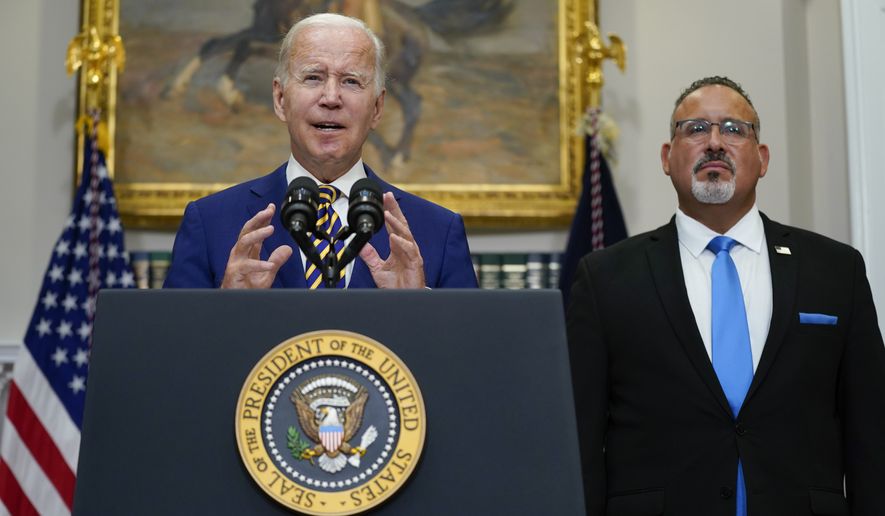Student loan servicers are still waiting for details on how the Department of Education will implement President Biden’s write-off of billions of dollars in student debt.
Industry insiders said a lack of coordination from the White House has put a smooth rollout of Mr. Biden’s plan at risk.
“The scope and detail of this program were not provided in advance to us or the Department of Education,” said Scott Buchanan, executive director of the Student Loan Servicing Alliance. “So we’re now, after the announcement last week, having discussions with them and working with them on what the implementation timeline and process will look like.”
The administration set an October deadline for the Department of Education to begin accepting applications from borrowers to slash up to $20,000 off individual debt.
Loan servicers need to know who’s getting the bailout and recalculate payment plans before January, when the COVID-19 pause on student debt payments ends. Mr. Buchanan said that, with details still being ironed out, the timeline will be tight.
“It’s going to be a push,” he said. “It’s going to be challenging for us and the department. We’re going to work towards those deadlines, but we’re also going to be focused on the most important thing here is, this needs to be done correctly.”
The White House did not respond to a request for comment.
After teasing his plan to forgive student loan debt since he was on the 2020 campaign trail, Mr. Biden announced last week that he would cancel up to $20,000 in debt for borrowers who earn less than $125,000 a year.
Mr. Biden also extended the pause on federal student loan payments through December, saying that restarting payments would help offset the cost of the debt write-off.
He then capped monthly payments on outstanding undergraduate loans at 5% of discretionary income, down from the current 10%. It forgives loan balances after 10 years of payments, instead of 20 years, for original loan balances of $12,000 or less.
Administration officials expect as many as 20 million people to have their student debt completely forgiven under the plan.
The finer details have yet to be worked out, including how borrowers apply for the taxpayer-financed forgiveness.
Soon after the announcement, officials told borrowers to sign up at StudentAid.gov to receive a notification when the application is ready. The site crashed when borrowers inundated it.
Loan servicers also were flooded with calls from borrowers who experienced long wait times only to be told, “We don’t have the guidance yet.”
“That’s frustrating for borrowers, but it’s the truth,” Mr. Buchanan said. “We’ve asked the government repeatedly when they make these announcements to give us heads-up so that we can plan and also give us talking points so that we can provide that to borrowers. We’re getting that in place now, but it’d be helpful to do it in advance.”
Even those fervently backing student loan forgiveness took shots at the lack of planning for the rollout.
“They had a year and a half to get ready and they did not have an application ready to roll out the day of the announcement,” the Debt Collective, a group that has called on Mr. Biden to wipe out the entire $1.8 trillion federal student debt balance, said on Twitter.
“Bad sign,” the group said.
The frustration over the rollout adds to the blowback on Mr. Biden.
Liberals who pressured Mr. Biden to cancel $50,000 of student debt or more per borrower complained that he didn’t go far enough.
Republicans criticized the move as an extension of out-of-control spending by Mr. Biden and his Democratic allies in Congress. Opponents also fault the plan for discriminating against those who repaid their college loans or received tuition breaks in return for military service or chose not to go to college.
Opponents on both sides of the aisle argued that student loan cancellation is a form of government spending and Congress, not the executive branch, controls the purse strings. That issue is expected to fuel court challenges that could derail the debt forgiveness for years, if not indefinitely.
With the widespread pushback over the plan, a choppy rollout threatens whatever remaining political benefit remains from announcing the plan ahead of the November elections. Democrats hoped it would energize young voters.
The added cash in the pockets of young voters stands to benefit Democrats, said Timothy Hagle, a political science professor at the University of Iowa, though that assumes they begin to see the fruits of the announcement ahead of the midterms.
A bungled rollout could have the opposite effect.
“If there’s a lot of frustration that goes into it, and they wasted a lot of time waiting around on a website, maybe trying to call support or whoever it is, then that can diminish that happiness fairly quickly,” Mr. Hagle said. “This is the kind of a thing where people get frustrated very quickly.”
Given the pages of fine print that still need to be worked out under tight deadlines, some experts say, the administration may have set up itself for failure.
“This is a heavy lift for the Department of Education to carry out the cancellation program and restart payments by Jan. 1,” said Charlie Eaton, a sociology professor at the University of California, Merced, and author of “Bankers in the Ivory Tower: The Troubling Rise of Financiers in US Higher Education.” “I think that’s an aggressive deadline.
“I would not rule out technical and administrative glitches, both foreseeable and unforeseeable. Ultimately, borrowers will blame the administration along with the loan servicers they hired,” he said.
• Joseph Clark can be reached at jclark@washingtontimes.com.




Please read our comment policy before commenting.